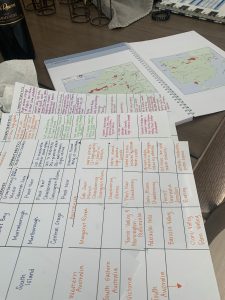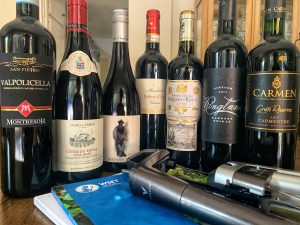This past weekend I (finally) took my WSET Level 2 exam! Months of flashcards, tastings, and studying maps culminated in a single 50-question online exam. I’m happy to say that the exam felt pretty easy, which I’m sure is a result of those daily study sessions!
My wine knowledge has expanded immensely as a result of the WSET Level 2 course. The information is dense, but truly formative in better understanding the landscape of the wine world. For the first time I feel confident walking into the French wine section at the store and understanding what the heck is inside those bottles. Because if you didn’t already know this, French wine is labeled by region, not grape varietal. So, you have to know what grapes are legally permitted to be grown in each region (and sometimes even specific villages) in order to have an idea of what type of French wine you might be drinking. The culture of winemaking in Europe, otherwise known as the “old world”, is wildly different than what we are used to in the United States!

WSET Level 2 felt daunting at first, having to learn theory and geography as well as develop the skillset to systematically taste and describe wine.
I remember other students so quickly and confidently calling out wine aromas and flavors during our first “live tasting class”. In that same moment, I felt like all I could smell was “wine”! What I learned, though, is that tasting and evaluating wine is a skill that anyone can develop with a bit of practice.
Combine that tasting skillset with knowledge of how climate, geography, and winemaking techniques influence the flavors of wine and suddenly you are able to “read” a wine like you read a book. Wine is both an art and a science that is completely dependent on climatic factors that are (mostly) outside of our control. Each glass tells a story of the interaction between a vineyard and the climate that it is subjected to, along with the viticulture and winemaking decisions that impact the flavor of the finished product. The WSET provides a deep dive into each of these components so you can learn to taste a wine and understand the story behind each glass. It is fascinating!

I thought that by my exam date I would be ready to let go of all of the studying and systematic tastings I’ve been doing for months.
Truth be told, I was almost a little bit sad once the exam was over. I realized how much I enjoyed starting my mornings reviewing flashcards alongside my cup of coffee, purchasing and tasting new varietals of wine I had never even heard of previously, and expanding my wine knowledge in ways that I know will help me be a better writer and educator. Rather than celebrating the end of the exam, I found myself immediately researching WSET Level 3 courses…what have I gotten myself into?!
I never took the WSET Level 1 course since I felt that I had enough baseline knowledge to bypass it. In hindsight that was the right decision for me personally, but for an enthusiast who is just beginning to learn the details of wine, that course would probably be a great fit. All in all, I think the WSET is a fantastic program for anyone who is interested in expanding their knowledge of wine. They also offer courses in spirits and sake if other beverages strike your fancy more than wine. I completed my course online through the Napa Valley Wine Academy which was a great experience.
This has been a fun ride in wine education so far. The question is, should I continue and enroll in Level 3??
The level 3 WSET course takes an even deeper dive into wine regions, begins to discuss market trends and pricing of wine, and features a variety of viticultural methods that influence wine. The exam is also much more intensive. It includes a 50-question exam, 4 theory essay questions, and a blind tasting of two wines. What’s your vote, should I give it a go? Let me know in the comments below!

Yes! Very impressive, way to go!
Go for it girlie!